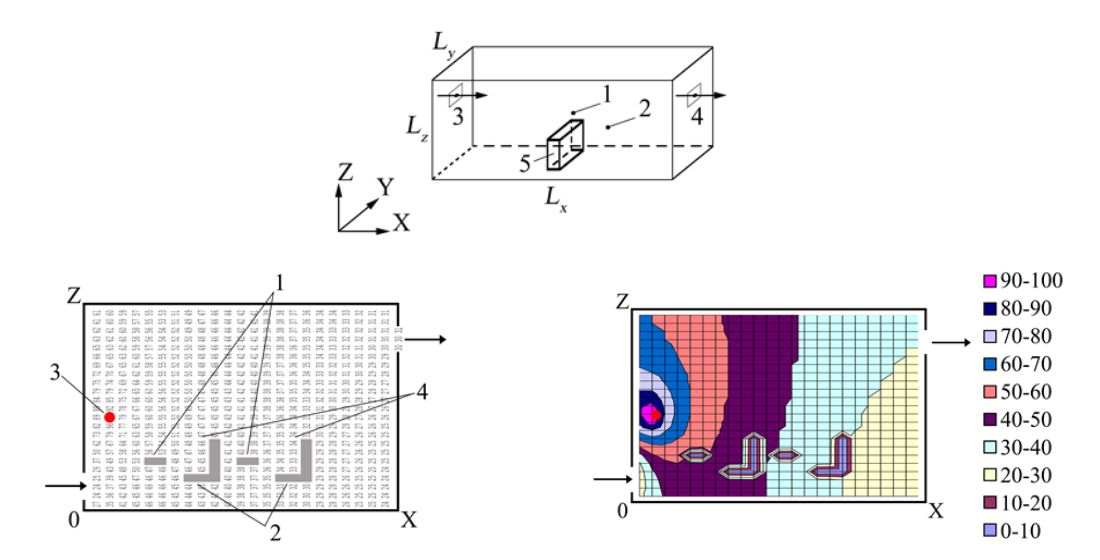Identifying regularities in the propagation of air ions in rooms with artificial air ionization
DOI:
https://doi.org/10.15587/1729-4061.2023.285967Keywords:
air quality in the room, artificial ionization, modeling of air ion propagation, air ion concentrationAbstract
The object of the study is the dynamics of air ion spread in rooms from the source of artificial air ionization under different starting conditions. There is currently the problem of distribution of air ions in the room with regulatory concentrations in all critical zones. An effective method of ensuring proper air ion concentrations is to model their propagation from ionization sources. Existing approaches to calculating the dynamics of air ions of both polarities have been improved in this study. Unlike known solutions, the impact on their concentration of electrostatic field and the interaction of air ions with suspended particles was taken into account.
A model of air ion propagation in rooms with artificial air ionization and the principles of its numerical modeling was built. The use of Laplace Equation in the aerodynamic model instead of the Navier-Stokes equation for the potential of the flow rate has made it possible to design an "Ion 3D" tool, which reduces the time of implementation of one scenario from several hours to 7 seconds. Modeling of the propagation of air ions of both polarities in the room under different initial conditions was carried out. Two-dimensional and three-dimensional models with their visualization was implemented. The peculiarity of the resulting models is that they make it possible to determine the concentrations of air ions in any section of the room by three coordinates. Given this, the rapid selection of the variants of the source data makes it possible to achieve the normative values of concentrations of air ions in the area of breathing – exceeding 500 cm-3 of each polarity. Simulation makes it possible to design a room in which, under the condition of artificial ionization of air, the concentrations of air ions close to the optimal values of 3000–5000 cm-3 are provided
References
- Wallner, P., Kundi, M., Panny, M., Tappler, P., Hutter, H.-P. (2015). Exposure to Air Ions in Indoor Environments: Experimental Study with Healthy Adults. International Journal of Environmental Research and Public Health, 12 (11), 14301–14311. doi: https://doi.org/10.3390/ijerph121114301
- Standard of Building Biology Testing Methods: SBM–2015. Institut für Baubiologie +Ökologie IBN. Available at: https://buildingbiology.com/site/downloads/standard-2015-englisch.pdf
- Bolibrukh, B., Glyva, V., Kasatkina, N., Levchenko, L., Tykhenko, O., Panova, O. et al. (2022). Monitoring and management ion concentrations in the air of industrial and public premises. Eastern-European Journal of Enterprise Technologies, 1 (10 (115)), 24–30. doi: https://doi.org/10.15587/1729-4061.2022.253110
- Sukach, S., Kozlovs’ka, T., Serhiienko, I., Khodakovskyy, O., Liashok, I., Kipko, O. (2018). Studying and substantiation of the method for normalization of airionic regime at industrial premises at the ultrasonic ionization of air. Eastern-European Journal of Enterprise Technologies, 4 (10 (94)), 36–45. doi: https://doi.org/10.15587/1729-4061.2018.141060
- Noakes, C. J., Sleigh, P. A., Beggs, C. B. (2007). Modelling the air cleaning performance of negative air ionisers in ventilated rooms. Proceeding of the 10 th Int. Conference on Air Distribution in Rooms. Helsinki. Available at: https://www.researchgate.net/publication/303547423_Modelling_the_air_cleaning_performance_of_negative_air_ionisers_in_ventilated_rooms
- Mayya, Y. S., Sapra, B. K., Khan, A., Sunny, F. (2004). Aerosol removal by unipolar ionization in indoor environments. Journal of Aerosol Science, 35 (8), 923–941. doi: https://doi.org/10.1016/j.jaerosci.2004.03.001
- Belyaev, N. N., Tsygankova, S. G. (2015). Matematicheskoe modelirovanie aeroionnogo rezhima v pomeschenii pri iskusstvennoy ionizatsii vozdukha. Stroitel'stvo. Materialovedenie. Mashinostroenie. Seriya: Bezopasnost' zhiznedeyatel'nosti, 83, 40–46. Available at: http://nbuv.gov.ua/UJRN/smmbz_2015_83_8
- Magnier-Bergeron, L., Derome, D., Zmeureanu, R. (2017). Three-dimensional model of air speed in the secondary zone of displacement ventilation jet. Building and Environment, 114, 483–494. doi: https://doi.org/10.1016/j.buildenv.2017.01.003
- Hryhorenko, I., Hryhorenko, S., Zhuk, O. (2023). The use of correlation analysis in assessing the uncertainty of the influence of external factors on the result of thermal control of biological objects. Advanced Information Systems, 7 (1), 66–70. doi: https://doi.org/10.20998/2522-9052.2023.1.11
- Iskandarov, N. (2022). Effect of ambient temperature on thermodynamic temperature measurements. Advanced Information Systems, 6 (3), 48–52. doi: https://doi.org/10.20998/2522-9052.2022.3.07
- TCO’03 Displays Flat Panel Displays Ver. 3.0 (2005). Available at: http://poradme.se/images/d/d7/Tco03.pdf

Downloads
Published
How to Cite
Issue
Section
License
Copyright (c) 2023 Larysa Levchenko, Nataliia Burdeina, Valentyn Glyva, Natalia Kasatkina, Mykola Biliaiev, Viktoriia Biliaieva, Oksana Tykhenko, Tetiana Petrunok, Yana Biruk, Oleg Bogatov

This work is licensed under a Creative Commons Attribution 4.0 International License.
The consolidation and conditions for the transfer of copyright (identification of authorship) is carried out in the License Agreement. In particular, the authors reserve the right to the authorship of their manuscript and transfer the first publication of this work to the journal under the terms of the Creative Commons CC BY license. At the same time, they have the right to conclude on their own additional agreements concerning the non-exclusive distribution of the work in the form in which it was published by this journal, but provided that the link to the first publication of the article in this journal is preserved.
A license agreement is a document in which the author warrants that he/she owns all copyright for the work (manuscript, article, etc.).
The authors, signing the License Agreement with TECHNOLOGY CENTER PC, have all rights to the further use of their work, provided that they link to our edition in which the work was published.
According to the terms of the License Agreement, the Publisher TECHNOLOGY CENTER PC does not take away your copyrights and receives permission from the authors to use and dissemination of the publication through the world's scientific resources (own electronic resources, scientometric databases, repositories, libraries, etc.).
In the absence of a signed License Agreement or in the absence of this agreement of identifiers allowing to identify the identity of the author, the editors have no right to work with the manuscript.
It is important to remember that there is another type of agreement between authors and publishers – when copyright is transferred from the authors to the publisher. In this case, the authors lose ownership of their work and may not use it in any way.









